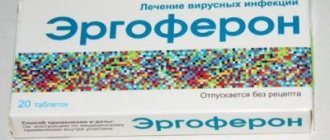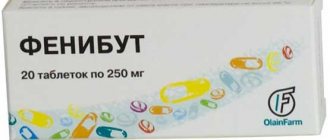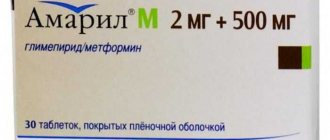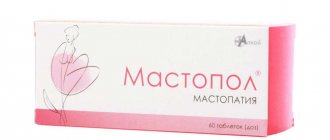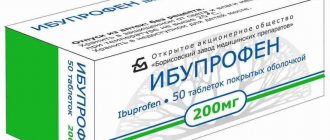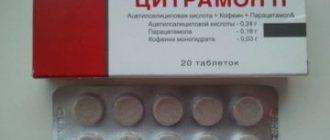pharmachologic effect
Ranitidine blocks histamine H2 receptors of parietal cells of the gastric mucosa, reduces basal and stimulated secretion of hydrochloric acid caused by irritation of baroreceptors, food load, the action of hormones and biogenic stimulants (gastrin, histamine, pentagastrin). Ranitidine reduces the volume of gastric juice and the content of hydrochloric acid in it, increases the pH of the stomach contents, which leads to a decrease in pepsin activity. After oral administration in therapeutic doses, it does not affect prolactin levels. Inhibits microsomal enzymes.
Duration of action after a single dose is up to 12 hours.
Pharmacokinetics
Rapidly absorbed; food intake does not affect the degree of absorption. When taken orally, the bioavailability of ranitidine is approximately 50%. Cmax in plasma is reached 2-3 hours after administration.
Plasma protein binding does not exceed 15%. Slightly metabolized in the liver to form desmethylranitidine and ranitidine S-oxide.
Has a first pass effect through the liver. The rate and degree of elimination depend little on the condition of the liver.
T1/2 after oral administration - 2.5 hours, with CC 20-30 ml/min - 8-9 hours. Excreted mainly in urine (60-70%, unchanged - 35%), a small amount - in feces. Penetrates poorly through the blood-brain barrier. Penetrates through the placenta. Excreted in breast milk (the concentration in breast milk in women during lactation is higher than in plasma).
Ranitidine tablets composition
1 film-coated tablet, 150 mg contains:
active substance: ranitidine 150 mg (in the form of ranitidine hydrochloride 167.41 mg);
excipients: microcrystalline cellulose (PH 101) - 81.81 mg, croscarmellose sodium - 1.27 mg, colloidal silicon dioxide - 1.27 mg, magnesium stearate 2.26 mg;
shell: hypromelpose 5.00 mg, triacetin - 1.84 mg, titanium dioxide E 171-1.27 mg, talc - 4.88 mg.
1 film-coated tablet 300 mg contains:
active substance: ranitidine 300 mg (in the form of ranitidine hydrochloride 334.83 mg);
excipients: microcrystalline cellulose (PH 101) - 112.82 mg, croscarmellose sodium - 4.60 mg, colloidal silicon dioxide - 3.20 mg, magnesium stearate - 4.60 mg; shell: hypromelpose - 9.35 mg, triacetin - 3.32 mg, talc - 8.00 mg, titanium dioxide E 171 - 2.31 mg,
brownlac: (sunset yellow dye E 110, azorubine dye E 122, black dye E 151) - 0.02 mg.
Description
Film-coated tablets 150 mg: round, biconvex, film-coated tablets, white to yellowish-white in color, characteristic odor. Film-coated tablets 300 mg: round, biconvex, film-coated tablets, pale pink in color, with a characteristic odor.
Pharmacotherapeutic group: agent that reduces the secretion of gastric glands - H2-histamine receptor blocker
ATX code: [A02BA02]
Pharmacological properties
Pharmacodynamics
Ranitidine is a blocker of H-histamine receptors of parietal cells of the gastric mucosa. Reduces basal and stimulated secretion of hydrochloric acid caused by irritation of baroreceptors, food load, the action of hormones and biogenic stimulants (gastrin, histamine, acetylcholine, pentagastrin, caffeine). Ranitidine reduces the volume of gastric juice and the content of hydrochloric acid in it, increases the pH of the stomach contents, which leads to a decrease in pepsin activity. Duration of action after a single dose is up to 12 hours.
Pharmacokinetics
Rapidly absorbed from the gastrointestinal tract; food intake does not affect the degree of absorption. When taken orally, the bioavailability of ranitidine is 50%. Communication with plasma proteins does not exceed 15%. Partially metabolized in the liver. The maximum plasma concentration is reached 2 hours after taking the film-coated tablets and ranges from 36 to 94 ng/ml. The half-life is 2-3 hours. 35% of the dose taken is excreted unchanged in the urine, and a small amount is excreted in feces. Penetrates through the placenta. Excreted in breast milk (the concentration in breast milk in women during lactation is higher than in plasma.)
What does Ranitidine help with: indications
- treatment and prevention of exacerbations of gastric and duodenal ulcers
- ulcers of the stomach and duodenum associated with taking NSAIDs
- reflux esophagitis, erosive esophagitis
- Zollinger-Ellson syndrome
- treatment and prevention of postoperative, “stress” ulcers of the upper gastrointestinal tract
- prevention of recurrent bleeding from the upper gastrointestinal tract
- prevention of aspiration of gastric juice during operations under general anesthesia (Mendelssohn syndrome).
Indications for use
When purchasing any medicine, you should consult your doctor in order to avoid negative consequences or side effects in the future. Before use, you must also read the instructions and strictly follow them. It is necessary to pay attention to the active substance and auxiliary components of the drug, and also analyze whether there is an allergic reaction or intolerance to any substance.
Indications for use are the presence of:
Peptic ulcer of the gastrointestinal tract or duodenum.
- The presence of gastritis with clearly increased secretory activity.
- Gastritis is not atrophic in nature.
- The presence of excessively increased hypersecretion of the stomach.
- Gastroduodenitis.
- The presence of a disease such as gastroesophageal reflux.
- Zollinger-Ellison syndrome.
Ranitidine is also actively used in complex therapy. Medical specialists often prescribe it when undergoing treatment with non-steroidal anti-inflammatory drugs (NSAIDs).
As practice shows, long-term treatment of NPS often leads to ulcerative lesions of the stomach walls. To avoid such unpleasant symptoms, it is necessary to approach treatment wisely and use medications in combination.
Gastroenterologists often prescribe treatment for them after surgical interventions, and sometimes even prescribe them to take a course before the planned operation. Since the drug has the ability to prevent the development of so-called stress ulcers or erosions.
It is also used to prevent unwanted bleeding caused by diseases of the upper gastrointestinal tract.
Ranitidine has become widespread in the use of prevention of diseases such as “gastrointestinal aspiration” - that is, the reflux of gastric juice into the human respiratory system before surgical interventions in which general anesthesia is used. In other words, it is most often used before operations on patients with Mendelssohn syndrome.
Do not forget about the side effects and contraindications that are indicated in the instructions. If the patient feels unwell or has an allergic reaction, you should stop taking the drug and consult your doctor.
Contraindications to the use of Ranitidine are:
- Hypersensitivity to the active substance included in the composition - ranitidine.
- The presence of diseases or severe disorders in the kidneys or liver.
- Presence of pregnancy or lactation period.
- Age up to twelve years (sometimes the use of the drug may be prescribed, but only if the dosage changes according to the child’s weight, or when it is strictly observed under medical supervision).
The drug should be used with caution if there is liver or kidney failure or the presence of a condition such as acute porphyria. In such cases, you need to start treatment if the benefits of the drug exceed the possible harm to the body.
Ranitidine: instructions for use
Orally, regardless of food intake, without chewing, with a small amount of liquid.
Adults and children over 12 years old
Peptic ulcer of the stomach and duodenum. For the treatment of exacerbations, 150 mg is prescribed 2 times a day (morning and evening) or 300 mg at night. If necessary, 300 mg 2 times a day. The duration of treatment is 4–8 weeks. To prevent exacerbations, 150 mg is prescribed at night, for smoking patients - 300 mg at night.
Ulcers associated with NSAIDs. Prescribe 150 mg 2 times a day or 300 mg at night for 8–12 weeks.
Prevention of ulcer formation when taking NSAIDs - 150 mg 2 times a day.
Postoperative and stress ulcers. Prescribe 150 mg 2 times a day for 4–8 weeks.
Erosive reflux esophagitis. Prescribe 150 mg 2 times a day or 300 mg at night. If necessary, the dose can be increased to 150 mg 4 times a day. The course of treatment is 8–12 weeks. Long-term preventive therapy - 150 mg 2 times a day.
Zollinger-Ellison syndrome. The initial dose is 150 mg 3 times a day; if necessary, the dose can be increased.
Prevention of recurrent bleeding. 150 mg 2 times a day.
Prevention of the development of Mendelssohn's syndrome. Prescribed at a dose of 150 mg 2 hours before anesthesia, and preferably 150 mg the night before. If there is concomitant liver dysfunction, a dose reduction may be necessary.
For patients with renal failure with creatinine Cl less than 50 ml/min, the recommended dose is 150 mg/day.
General characteristics of the drug
For the drug Ranitidine, the placenta is not a significant barrier. For this reason, the active substance of this medication also passes into breast milk. Moreover, it is contained there in higher concentrations than in plasma.
In pharmacies, the medicine is available in tablet form and as an injection solution. The tablets are orange or pink, convex on both sides, round, made with different contents of the active substance:
- 150 mg per tablet;
- 300 mg per tablet.
At lower dosages, the color of the coating of the drug Ranitidine ranges from white to orange. The product with a higher concentration of the active component is covered with a pink film shell.
The drug Ranitidine helps to reduce the overall acidity of the stomach
If it is not possible to take the drug in tablets, you can purchase Ranitidine-Ferein - this is an injection solution.
Side effects
From the digestive system: nausea, dry mouth, constipation, vomiting, diarrhea, abdominal pain rarely - hepatocellular, cholestatic or mixed hepatitis, acute pancreatitis.
From the hematopoietic organs: leukopenia, thrombocytopenia, agranulocytosis, pancytopenia, bone marrow hypo- and aplasia, immune hemolytic anemia.
From the cardiovascular system: decreased blood pressure, bradycardia, arrhythmia, atrioventricular block.
From the nervous system: increased fatigue, drowsiness, headache, dizziness, rarely - confusion, tinnitus, irritability, hallucinations (mainly in elderly patients and seriously ill patients), involuntary movements.
From the senses: blurred visual perception, accommodation paresis.
From the musculoskeletal system: arthralgia, myalgia.
From the endocrine system: hyperprolactinemia, gynecomastia, amenorrhea, decreased libido, impotence.
Allergic reactions: urticaria, skin rash, angioedema, anaphylactic shock, bronchospasm, erythema multiforme.
Other: alopecia, hypercreatininemia.
Pharmacological properties
Ranitidine Akos is an antiulcer drug, the active substance of which belongs to the group of histamine H2 receptor antagonists. The principle of action is based on blocking H2 receptors in parietal cells located in the gastric mucosa, as well as on inhibiting the production of hydrochloric acid. Under the influence of the active substance, the volume of total secretion decreases, suppressing the activity of pepsin in gastric juice.
Thanks to the antisecretory effect of Ranitidine, it is possible to create favorable conditions for the healing of ulcerative lesions in the digestive tract (stomach, duodenum). The active substance is capable of exerting a protective effect by enhancing reparative processes, increasing the secretion of special mucous substances, and improving microcirculation.
There is a decrease in ranitidine absorption rates when treated with antacids. Elderly patients experience deterioration in attention and memory while taking anticholinergic drugs. It is assumed that medications that block histamine H2 receptors are able to suppress the ulcerogenic effect of drugs from the NSAID group on the gastric mucosa.
There may be an undesirable increase in the absorption rates of ranitidine during simultaneous therapy with bismuth tripotassium dicitrate. Cases of hypoglycemia have been reported when taking Glibenclamide.
Ranitidine inhibits the absorption of Itraconazole and Ketoconazole. The half-life of Metoprolol and its AUC increase during treatment with Ranitidine. The absorption of the drug changes when taking high doses of Sucralfate (more than 2 g).
There is a slowdown in the excretion of Procainamide through the renal system, which leads to an increase in the concentration of the active substance in the blood. The absorption of Triazolam increases, which is associated with a change in the pH of gastric juice. The risk of toxicity increases with treatment with Phenytoin, which is explained by a significant increase in its concentration in the blood. There is an increase in the bioavailability of Furosemide with simultaneous therapy with Ranitidine.
In the medical literature there is a description of a case of the development of ventricular arrhythmia of the bigeminy type in a patient who took Ranitidine and Quinidine. When treated with Cisapride, the risk of cardiotoxicity increases. There is an increase in the level of Cyclosporine in the blood with parallel treatment with Ranitidine.
Pharmacodynamics
Ranitidine is a blocker of histamine H2 receptors on parietal cells that make up the gastric mucosa. It suppresses basal and stimulated production of hydrochloric acid due to dietary load, baroreceptor irritation and the effects characteristic of biogenic stimulants (pentagastrin, gastrin, histamine) and hormones.
Pharmacokinetics
When taken orally, the bioavailability of ranitidine is approximately 50%. The substance binds to plasma proteins by no more than 15% and is partially involved in metabolic processes occurring in the liver. Its maximum content in plasma is achieved 2 hours after taking the tablets. The half-life of ranitidine is 2–3 hours.
- Allergic reactions: bronchospasm, skin rash, urticaria, anaphylactic shock, Quincke's edema, erythema multiforme;
- From the cardiovascular system: atrioventricular block, bradycardia, decreased blood pressure, arrhythmia;
- From the musculoskeletal system: myalgia, arthralgia;
- From the nervous system: headache, drowsiness, dizziness, increased fatigue; rarely - tinnitus, involuntary movements, irritability, confusion, hallucinations (more often in older people and seriously ill patients);
- From the hematopoietic organs: bone marrow hypo- and aplasia, agranulocytosis, immune hemolytic anemia, thrombocytopenia, leukopenia, pancytopenia;
- From the digestive system: dry mouth, abdominal pain, diarrhea/constipation, nausea and/or vomiting; rarely - acute pancreatitis, cholestatic, hepatocellular or mixed hepatitis;
- From the endocrine system: amenorrhea, gynecomastia, decreased libido, hyperprolactinemia, impotence;
- From the senses: accommodation paresis, blurred visual perception;
- Other: hypercreatininemia, alopecia.
Please note that ranitidine:
- Inhibits the metabolism in the liver of indirect anticoagulants, calcium antagonists, aminophenazone, glipizide, diazepam, lidocaine, metronidazole, propranolol, phenazone, theophylline, hexobarbital, buformin, aminophylline, phenytoin;
- Increases serum concentration and half-life of metoprolol;
- Reduces the absorption of ketoconazole and itraconazole.
Smoking reduces the effectiveness of ranitidine.
With the simultaneous use of drugs that have an inhibitory effect on the bone marrow, the risk of developing neutropenia increases.
Antacids and sucralfate in high doses may slow down the absorption of ranitidine, so a minimum of 2-hour intervals should be maintained between doses.
Side effects when taking Ranitidine are rare. These may be phenomena associated with the cardiovascular and nervous systems, and the digestive tract.
Adverse reactions related to the cardiovascular system:
- bradycardia;
- decreased blood pressure;
- atrioventricular block, mainly with parenteral administration;
- arrhythmias.
Adverse reactions related to the nervous system:
- dizziness,
- headache,
- increased fatigue,
- drowsiness,
- noise in ears,
- decreased clarity of vision.
In seriously ill patients, confusion and hallucinations are possible.
Adverse reactions associated with the gastrointestinal tract:
- nausea,
- vomit,
- constipation,
- diarrhea,
- abdominal pain.
Allergic reactions of the following type are also possible:
- hives,
- rash,
- angioedema.
Possible changes in blood composition (thrombocytopenia, leukopenia, agranulocytosis), hepatitis, decreased potency or libido, gynecomastia, dry mouth, arthralgia and myalgia, bronchospasm, hair loss.
During the course of taking the drug, it is best to avoid driving due to possible side effects associated with the nervous system. Ranitidine metabolites may give a false-positive test for amphetamine.
Main symptoms of overdose:
- skin rashes,
- confusion,
- headache,
- dizziness.
Treatment of overdose is symptomatic. Cleansing of the gastrointestinal tract using enterosorbents is indicated.
Antacids make it difficult to absorb the drug. Therefore, when taking antacids and Ranitidine simultaneously, an interval of 2 hours should be maintained between the use of these drugs. The same applies to the simultaneous use of Itroconazole and Ketoconazole together with the drug.
Inhibits the metabolism of certain drugs in the liver, including diazepam, metronidazole, indirect anticoagulants, lidocaine.
Ranitidine increases the bioavailability of furosemide. Concomitant use with anticholinergic drugs may contribute to memory and attention impairment in elderly patients.
Smoking is a factor that reduces the effectiveness of the drug.
Ranitidine can mask the symptoms that occur with gastric carcinoma, therefore, before prescribing the drug, the doctor must make sure that the patient does not have cancer. Also, do not suddenly stop taking Ranitidine, as this may lead to relapses of the disease. Practice has shown that the most effective regimen is one that involves taking the drug for 45 days in the autumn and spring.
Rapid intravenous administration of ranitidine can provoke an attack of bradycardia. The drug is prescribed with caution to persons with a history of porphyria, as an acute attack of porphyria may occur.
Ranitidine may cause false positive results in urine protein tests. The drug may also interfere with the normal skin reaction to allergens (due to its effect on histamine receptors). Therefore, before such tests, the drug should be stopped.
During the course of treatment with Ranitidine, you should follow a diet consisting of avoiding foods that can cause irritation of the gastric mucosa.
special instructions
Treatment with ranitidine may mask symptoms associated with gastric carcinoma, so the presence of a cancer-ulcer must be excluded before starting treatment.
Ranitidine, like all H2-histamine blockers, is undesirable sharply o).
With long-term treatment of weakened patients under stress, bacterial damage to the stomach is possible with subsequent spread of infection.
There is evidence that ranitidine can cause acute attacks of porphyria.
H2-receptor blockers should be taken 2 hours after taking itraconazole or ketoconazole to avoid a significant decrease in their absorption.
May increase glutamate transpeptidase activity.
May cause a false positive reaction to a protein test in the urine.
H2-histamine receptor blockers can counteract the effect of pentagastrin and histamine on the acid-forming function of the stomach, therefore, within 24 hours preceding the test, the use of H2-histamine receptor blockers is not recommended.
Histamine H2 blockers may suppress the skin reaction to histamine, thus leading to false-positive results (it is recommended that H2 blockers be discontinued before performing diagnostic skin tests to detect an immediate allergic skin reaction).
During treatment, you should avoid consuming foods, drinks and other medications that may irritate the gastric mucosa.
Use in pediatrics
The safety and effectiveness of ranitidine in children under 12 years of age have not been established.
Impact on the ability to drive vehicles and operate machinery
During the treatment period, it is necessary to refrain from engaging in potentially hazardous activities that require increased concentration and speed of psychomotor reactions.
Composition and release form
Dosage form – film-coated tablets: round, biconvex, light orange in color (in blisters of 10 tablets, 2 blisters in a cardboard box).
- Active ingredient: ranitidine (in the form of hydrochloride) – 150 or 300 mg per tablet.
Auxiliary components: Kollidon VA-64, corn starch, colloidal silicon dioxide, propylene glycol, polyethylene glycol 6000, sodium lauryl sulfate, hypromellose, magnesium stearate, ethylcellulose, microcrystalline cellulose, titanium dioxide, sunset yellow dye.
Compatibility with other drugs
Smoking reduces the effectiveness of ranitidine.
Increases the concentration of metoprolol in the blood serum (by 80% and 50%, respectively), while the half-life of metoprolol increases from 4.4 to 6.5 hours.
Due to an increase in the pH of the gastric contents, the absorption of itraconazole and ketoconazole may be reduced when taken simultaneously.
Inhibits the metabolism in the liver of phenazone, aminophenazone, diazepam, hexobarbital, propracolol, diazepam, lidocaic, phenytoin, theophylline, aminophylline, indirect anticoagulants, glipizide, buformin, metronidazole, calcium antagonists.
Bone marrow depressants increase the risk of neutropenia.
When used simultaneously with antacids or sucralfate in high doses, the absorption of ranitidine may be slowed down, so the break between taking these drugs should be at least 2 hours.

